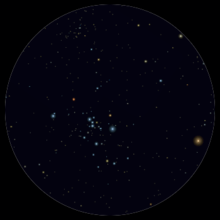KQ Puppis
| Observation data Epoch J2000 Equinox J2000 | |
|---|---|
| Constellation | Puppis |
| Right ascension | 07h 33m 47.96383s[1] |
| Declination | −14° 31′ 26.0026″[1] |
| Apparent magnitude (V) | +4.97[2] (4.82 - 5.17[3]) |
| Characteristics | |
| Spectral type | M2Iab + B0Ve[4] |
| U−B color index | +0.29[2] |
| B−V color index | +1.41[2] |
| Variable type | LC[3] |
| Astrometry | |
| Radial velocity (Rv) | +22[5] km/s |
| Proper motion (μ) | RA: -6.98[1] mas/yr Dec.: +4.82[1] mas/yr |
| Parallax (π) | 2.12 ± 0.45[1] mas |
| Distance | 1,400[6] pc |
| Orbit[6] | |
| Period (P) | 9,752 days |
| Eccentricity (e) | 0.46 |
| Inclination (i) | 60-80° |
| Details | |
| Cool primary | |
| Mass | 13-20[6] M☉ |
| Radius | 570[6] R☉ |
| Luminosity | 59,800[6] L☉ |
| Temperature | 3,662[7] K |
| Hot secondary | |
| Mass | 17[6] M☉ |
| Radius | 4.35[6] R☉ |
| Luminosity | 13,800[6] L☉ |
| Temperature | 30,000[6] K |
| Other designations | |
| Primary: HD 60414 | |
| Secondary: HD 60415 | |
| Database references | |
| SIMBAD | data |

KQ Puppis (KQ Pup) is a spectroscopic binary variable star in the constellation Puppis. A red supergiant star and a hot main sequence star orbit each other every 9,742 days. Its apparent magnitude varies between 4.82 and 5.17.
The KQ Puppis system consists of a fairly typical M2 supergiant, in orbit with a hotter less luminous star. The hotter star is surrounded by a disc of material being transferred from the cool supergiant. This type of binary is referred to a VV Cephei system, although in this case there are no eclipses of either star.[6] A portion of the disc does appear to be eclipsed and this is detected as a strong drop in far-ultraviolet radiation for about a third of the orbit.[4]
The red supergiant primary star has been compared to Betelgeuse.[6] It shows small amplitude irregular pulsations, and also some variation associated with the orbital motion.[8] The nature of the secondary is less certain. The spectrum shows high excitation features that would indicate an early B or hotter spectral type, but these may be associated with the disc rather than that star itself. Other studies have found a spectrum similar to an A supergiant, but this is thought to be an artefact of a B-type shell star.[9]
KQ Puppis has been catalogued as an outlying member of the open cluster Messier 47 (NGC 2422) and would be the brightest member of that cluster.[10] Membership is uncertain as it appears to be more distant than the other stars in the cluster.[11]
References
- 1 2 3 4 5 Van Leeuwen, F. (2007). "Validation of the new Hipparcos reduction". Astronomy and Astrophysics. 474 (2): 653. arXiv:0708.1752
 . Bibcode:2007A&A...474..653V. doi:10.1051/0004-6361:20078357.
. Bibcode:2007A&A...474..653V. doi:10.1051/0004-6361:20078357. - 1 2 3 Ducati, J. R. (2002). "VizieR Online Data Catalog: Catalogue of Stellar Photometry in Johnson's 11-color system". CDS/ADC Collection of Electronic Catalogues. 2237: 0. Bibcode:2002yCat.2237....0D.
- 1 2 Samus, N. N.; Durlevich, O. V.; et al. (2009). "VizieR Online Data Catalog: General Catalogue of Variable Stars (Samus+ 2007-2013)". VizieR On-line Data Catalog: B/gcvs. Originally published in: 2009yCat....102025S. 1: 02025. Bibcode:2009yCat....102025S.
- 1 2 González-Riestra, R.; Rossi, C.; Viotti, R. F. (2003). "First far-UV observations of KQ Puppis with FUSE". Astronomy and Astrophysics. 399 (2): 681. Bibcode:2003A&A...399..681G. doi:10.1051/0004-6361:20021830.
- ↑ Wilson, Ralph Elmer (1953). "General catalogue of stellar radial velocities". Washington: 0. Bibcode:1953GCRV..C......0W.
- 1 2 3 4 5 6 7 8 9 10 11 Rossi, C.; Altamore, A.; Baratta, G. B.; Friedjung, M.; Viotti, R. (1992). "The spectrum of the VV Cephei star KQ Puppis (Boss 1985). III - A possible model". Astronomy and Astrophysics. 256: 133. Bibcode:1992A&A...256..133R.
- ↑ McDonald, I.; Zijlstra, A. A.; Boyer, M. L. (2012). "Fundamental parameters and infrared excesses of Hipparcos stars". Monthly Notices of the Royal Astronomical Society. 427: 343. Bibcode:2012MNRAS.427..343M. doi:10.1111/j.1365-2966.2012.21873.x.
- ↑ Viotti, R.; Rossi, C.; Muratorio, G. (1998). "Optical and near-IR observations of variable stars with AURELIE". Astronomy and Astrophysics Supplement. 128 (3): 447. Bibcode:1998A&AS..128..447V. doi:10.1051/aas:1998156.
- ↑ Parsons, Sidney B.; Ake, Thomas B. (1998). "Ultraviolet and Optical Studies of Binaries with Luminous Cool Primaries and Hot Companions. V. The Entire IUE Sample". The Astrophysical Journal Supplement Series. 119: 83. Bibcode:1998ApJS..119...83P. doi:10.1086/313152.
- ↑ Van Schewick, H. (1966). "Untersuchungen uber die Eigenbewegungen von Sternhaufen. XII. NGC 2422, NGC 2423, NGC 7209 und An. Bakhatova I im Sel. Area 40". Veroeff. Univ. Sternw. Bonn. 74: 1. Bibcode:1966VeBon..74....1V.
- ↑ Baumgardt, H.; Dettbarn, C.; Wielen, R. (2000). "Absolute proper motions of open clusters. I. Observational data". Astronomy and Astrophysics Supplement. 146 (2): 251. arXiv:astro-ph/0010306
 . Bibcode:2000A&AS..146..251B. doi:10.1051/aas:2000362.
. Bibcode:2000A&AS..146..251B. doi:10.1051/aas:2000362.